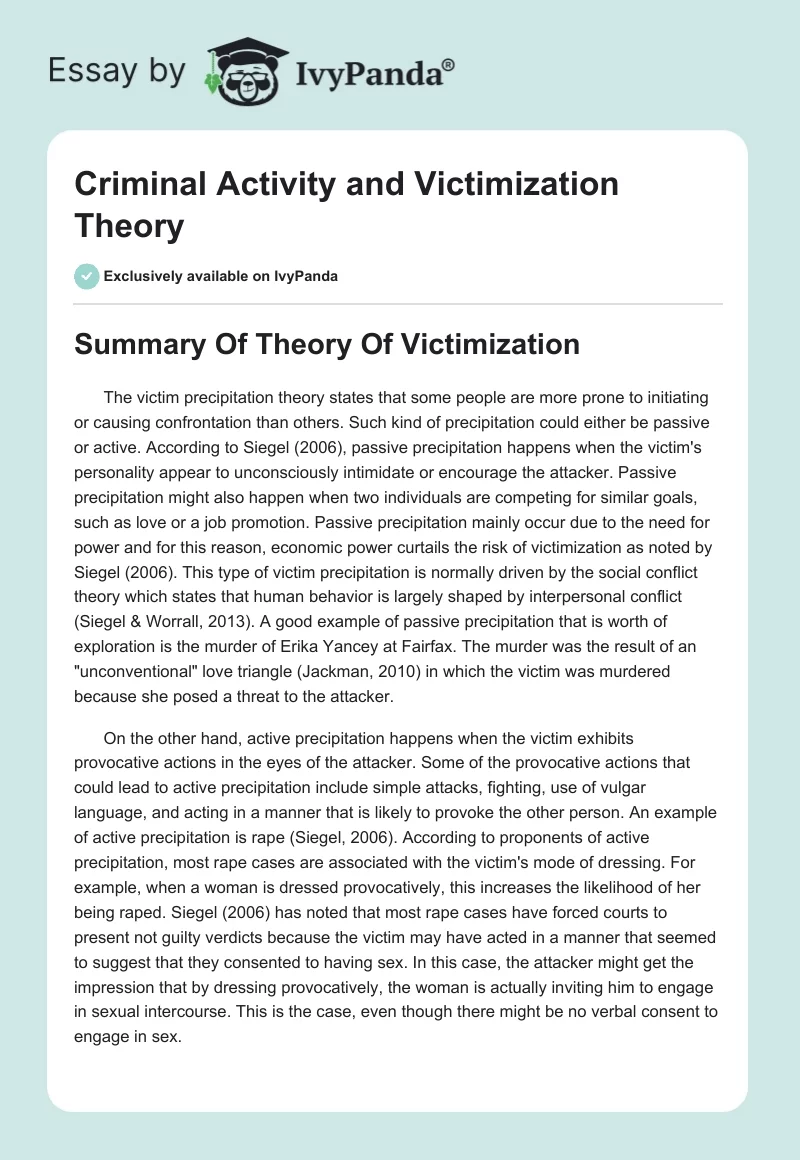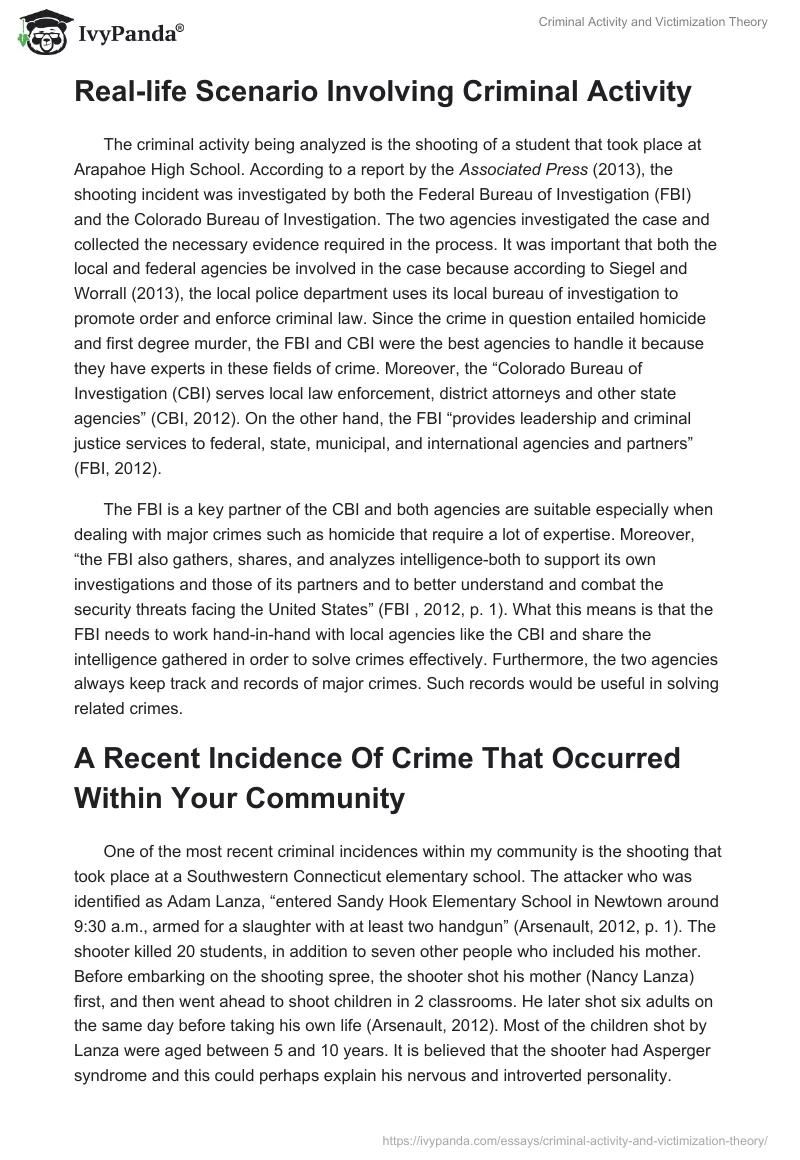Summary Of Theory Of Victimization
The victim precipitation theory states that some people are more prone to initiating or causing confrontation than others. Such kind of precipitation could either be passive or active. According to Siegel (2006), passive precipitation happens when the victim’s personality appears to unconsciously intimidate or encourage the attacker. Passive precipitation might also happen when two individuals are competing for similar goals, such as love or a job promotion.
Passive precipitation mainly occurs due to the need for power and for this reason, economic power curtails the risk of victimization as noted by Siegel (2006). This type of victim precipitation is normally driven by the social conflict theory which states that human behavior is largely shaped by interpersonal conflict (Siegel & Worrall, 2013). A good example of passive precipitation that is worth of exploration is the murder of Erika Yancey at Fairfax. The murder was the result of an “unconventional” love triangle (Jackman, 2010) in which the victim was murdered because she posed a threat to the attacker.
On the other hand, active precipitation happens when the victim exhibits provocative actions in the eyes of the attacker. Some of the provocative actions that could lead to active precipitation include simple attacks, fighting, use of vulgar language, and acting in a manner that is likely to provoke the other person. An example of active precipitation is rape (Siegel, 2006). According to proponents of active precipitation, most rape cases are associated with the victim’s mode of dressing. For example, when a woman is dressed provocatively, this increases the likelihood of her being raped.
Siegel (2006) has noted that most rape cases have forced courts to present not-guilty verdicts because the victim may have acted in a manner that seemed to suggest that they consented to having sex. In this case, the attacker might get the impression that by dressing provocatively, the woman is actually inviting him to engage in sexual intercourse. This is the case, even though there might be no verbal consent to engage in sex.
Real-life Scenario Involving Criminal Activity
The criminal activity being analyzed is the shooting of a student that took place at Arapahoe High School. According to a report by the Associated Press (2013), the shooting incident was investigated by both the Federal Bureau of Investigation (FBI) and the Colorado Bureau of Investigation. The two agencies investigated the case and collected the necessary evidence required in the process. It was important that both the local and federal agencies be involved in the case because according to Siegel and Worrall (2013), the local police department uses its local bureau of investigation to promote order and enforce criminal law.
Since the crime in question entailed homicide and first-degree murder, the FBI and CBI were the best agencies to handle it because they have experts in these fields of crime. Moreover, the “Colorado Bureau of Investigation (CBI) serves local law enforcement, district attorneys and other state agencies” (CBI, 2012). On the other hand, the FBI “provides leadership and criminal justice services to federal, state, municipal, and international agencies and partners” (FBI, 2012).
The FBI is a key partner of the CBI and both agencies are suitable especially when dealing with major crimes such as homicide that require a lot of expertise. Moreover, “the FBI also gathers, shares, and analyzes intelligence to support its own investigations and those of its partners and to better understand and combat the security threats facing the United States” (FBI, 2012, p. 1). What this means is that the FBI needs to work hand-in-hand with local agencies like the CBI and share the intelligence gathered in order to solve crimes effectively. Furthermore, the two agencies always keep track and records of major crimes. Such records would be useful in solving related crimes.
A Recent Incidence Of Crime That Occurred Within Your Community
One of the most recent criminal incidences within my community is the shooting that took place at a Southwestern Connecticut elementary school. The attacker who was identified as Adam Lanza, “entered Sandy Hook Elementary School in Newtown around 9:30 a.m., armed for a slaughter with at least two handguns” (Arsenault, 2012, p. 1). The shooter killed 20 students, in addition to seven other people who included his mother. Before embarking on the shooting spree, the shooter shot his mother (Nancy Lanza) first and then went ahead to shoot children in 2 classrooms. He later shot six adults on the same day before taking his own life (Arsenault, 2012). Most of the children shot by Lanza were aged between 5 and 10 years. It is believed that the shooter had Asperger syndrome and this could perhaps explain his nervous and introverted personality.
Sgt. Barry Evans notes that there are different ways that could be adopted within the strata of the community to help in the adoption and selection of measures within the community to curb crime. The adoption of such measures ensures that the crime-prone areas are safer, in addition to preventing certain offenders from engaging out in criminal activities. In addition, the measures lessen the probability that people will turn out to be victims of crime. In regards to the crime under discussion, community policing is an effective strategy of prevent such related crimes (Miller, Hess & Orthmann, 2011).
For example, the local community could partner with the local police force in high-crime neighborhoods in developing programs aimed at preventing victimization and other related crimes (Miller et al., 2011). In the current context, community policing strategies could actually help to combat shooting crimes. For example, placing police officers and community members at schools would go a long way in detecting possible threats. Moreover, metal scanners could be used in these schools to detect people carrying guns or crude weapons to schools.
Another method that could be used to prevent such kinds of crime is the enforcement of gun-control laws (Fabian, 2012). In this case, gun-control laws could be used to cut down the number of assault weapons possessed by the public. Based on a 2008 study conducted by the Brady Campaign to Prevent Gun Violence, the findings established that “a stronger, more comprehensive law would enhance public safety even more” (Fabian, 2012, p.1). This means that gun-control laws could have prevented such kinds of crimes by reducing the number of guns in the hands of the public. Although the action contravenes the Second Amendment that promises an individual the right to possess a firearm, the law would close the current loopholes and keep guns from dangerous hands (White House 2012). Moreover, the ban on military-style assault weapons can reduce gun violence.
Reference List
- Associated Press (2013). Shooting investigators turn over school building. Web.
- Arsenault, M. (2012). Gunman’s rampage leaves 20 children dead at Conn. elementary school: ‘Evil visited this community today’. Web.
- CBI. (2012). Investigative services. Web.
- Fabian, J. (2012). Lawmakers Propose New Gun Laws: Can They Prevent Another Newtown? Web.
- FBI. (2012). FBI; Overviews. Web.
- Jackman, T. (2010). Fairfax murder trial features love triangle, DNA, mystery. Web.
- Miller, L. S., Hess, K. M., & Orthmann, C. M. H. (2011). Community policing: Partnerships for problem solving. Adelaide, Australia: Delmar Cengage Learning
- Seigel, L., J. (2006). Criminology, 10th Edition. Boston, Massachusetts: Thomson Wadsworth.
- Siegel, L. J., & Worrall, J. L. (2013). Essentials of criminal justice (8th ed.). Belmont, CA: Wadsworth/ Cengage Learning.
- White House. (2012). The President’s plan to protect our children and our communities by reducing gun violence. Web.


